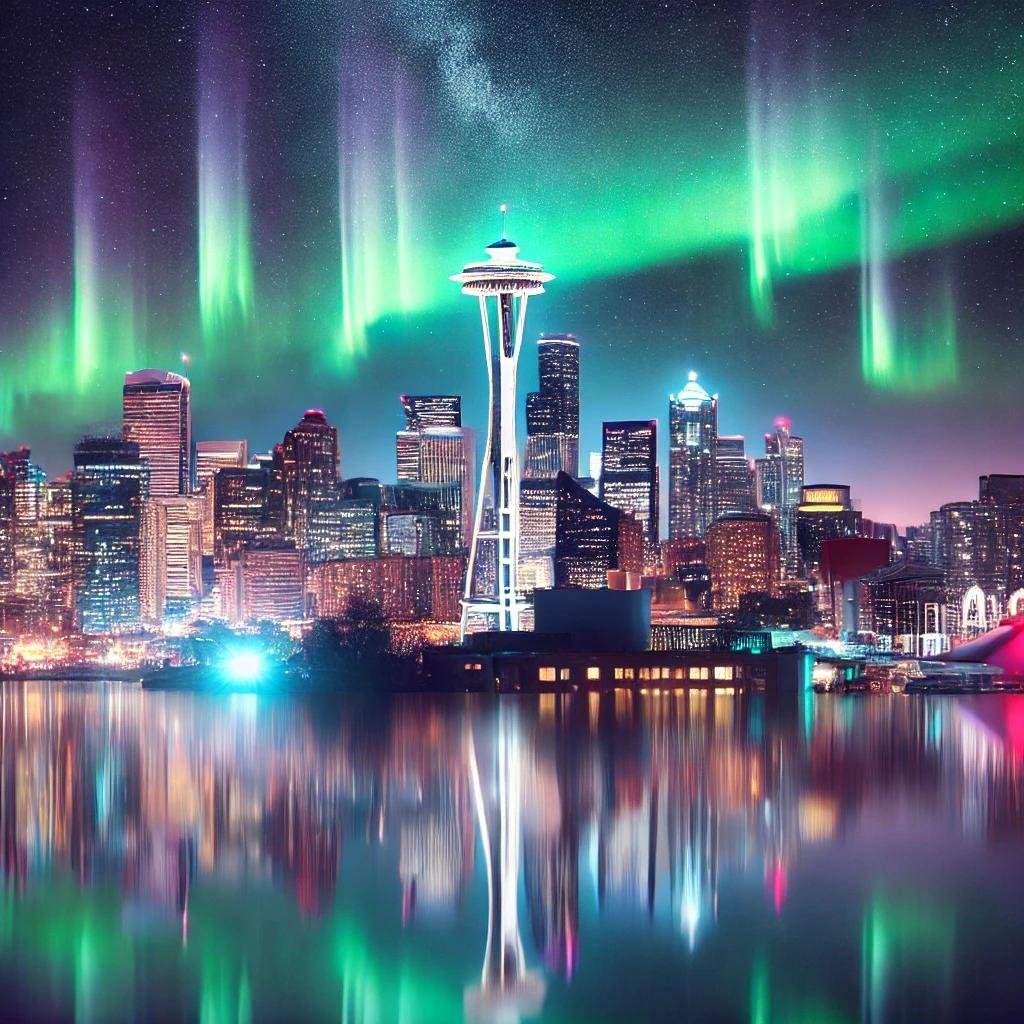First Introduction
Skywatchers are enthralled with the rare yet amazing natural phenomenon known as the aurora borealis, or Seattle Northern Lights. Because of its southern latitude and frequent cloud cover, Seattle is not the best place for consistent aurora sightings; yet, during times of great solar activity one can see this amazing light show.
This book addresses all you need to know about observing the Northern Lights in Seattle, including the ideal times, viewing sites, and advice for optimizing your chances of seeing this beautiful celestial occurrence.
What Generates the Northern Lights?
Charged particles from the sun mix with the Earth’s atmosphere to produce vivid displays of green, pink, purple, and blue lights known as the Northern Lights. These lights are most often seen close to the magnetic poles (such as in Alaska, Canada, and Norway), but during intense geomagnetic storms the auroras may be seen considerably further south—including Seattle, Washington.
Do the Northern Lights Show Up in Seattle?
Indeed, but only under appropriate circumstances. Though it is rare in Seattle, the aurora borealis is seen when solar activity is strong and the heavens are clear. Strong geomagnetic storms (Kp index of 6 or above) when the aurora oval stretches southward offer the best prospects.
Affective Elements Influencing Visibility:
- Solar Activity: Strong solar storms force the aurora farther south, where it is seen in cities like Seattle.
- Light Pollution: City lights can hide the aurora; so, it is advisable to visit darker regions.
- Weather: Cloudy or wet skies will obscure visibility.
- Time of Year: Longer, darker evenings provided by fall and winter months enhance viewing conditions.
Best Dates to View the Northern Lights in Seattle
Solar activity and weather variables determine when the Seattle Northern Lights would be most visible. You have the best possibilities right here:
1. Period of Peak Solar Activity
Northern Lights activity tracks an 11-year solar cycle. Around 2025, the next peak is projected, so auroral activity in the next years could rise.
2. Fall and Winter Months (September through March)
- Longer nights give aurora watchers additional darkness.
- Less cloud coverage enhances visibility.
3. Strong Geomagnetic Storms (Kp 6 or Higher)
- On a 0 to 9 scale, the Kp index gauges geomagnetic activity.
- A Kp of 6+ raises the possibility of auroras showing up in Seattle.
- Aurora forecasts are available on websites including NOAA’s Space Weather Prediction Center (SWPC).
Greatest Viewpoints for the Northern Lights Close to Seattle
Head away from city lights to optimize your chances of witnessing the aurora borealis. Near Seattle, these are some of the best dark-sky sites:
1. Rattlesnake Lake (45-minute drive from Seattle)
- Low light pollution.
- Wide-open skies for improved visibility.
2. Gold Creek Pond (One hour from Seattle)
- Located close to Snoqualmie Pass.
- Presents amazing views of the lake during aurora activity.
3. Mount Rainier National Park (Three hours from Seattle)
- Among Washington’s top dark-sky locations.
- Higher elevation offers better views of the sky.
4. Whidbey Island (One and a half hours from Seattle)
- Less light pollution than in the city.
- Simple access for visitors from Seattle.
5. Artist Point (Three hours from Seattle)
- This region, which lies close to Mount Baker, presents an amazing perspective of the northern horizon.
Advice on Seeing and Filming the Northern Lights
1. Consult the Aurora Forecast
- Track activity using apps including NOAA’s Aurora Forecast, Space Weather Live, and Aurora Alerts.
- For Seattle visibility, look for a Kp index of 6+.
2. Choose a Dark, Elevated Spot
- Avoid city lights and seek higher altitudes for better viewing.
3. Get Ready for Cold Nights
- Dress warmly, particularly if you are heading to the mountains.
- For extended waits, pack blankets, hot drinks, and a comfortable chair.
4. Use a Manual-Setting Camera
- A DSLR or mirrorless camera with a tripod works best.
- Adjust to ISO 800-1600, f/2.8-f/4, and 10–20 second shutter speed for the best shots.
5. Be Late and Patient
- Auroras can be unpredictable and may appear for only a few minutes.
- The ideal sightings fall between 10 PM and 2 AM.
Commonly Asked Questions (FAQs)
READ ABOUT-Rockefeller Christmas Tree Lighting: Everything You Need to Know
1. How often can one view the Northern Lights in Seattle?
- Rare but occasionally occurring during intense geomagnetic storms (Kp 6 or above).
2. Which months are ideal for seeing the Northern Lights in Seattle?
- September through March offer the best opportunities since nights are longer and darker.
3. What is the Kp index, and how does it affect aurora visibility?
- The Kp index measures geomagnetic activity on a 0 to 9 scale.
- Auroras usually require a Kp of at least 6 to be visible in Seattle.
4. Can I see the Northern Lights from downtown Seattle?
- Unlikely due to light pollution.
- You need to travel to darker areas outside the city.
5. Which app provides the best Northern Lights alerts?
- Popular apps for real-time aurora forecasts include:
- Aurora Alerts
- My Aurora Forecast
- Space Weather Live
In Essence
Though Seattle is not the finest location to view the Northern Lights, significant solar activity makes it feasible. Maximizing your chances of seeing this captivating natural wonder requires tracking aurora forecasts, visiting dark-sky sites like Mount Rainier or Rattlesnake Lake, and using proper viewing techniques.
Now is the ideal time to start planning your Seattle Northern Lights trip as the next solar peak is expected around 2025.

